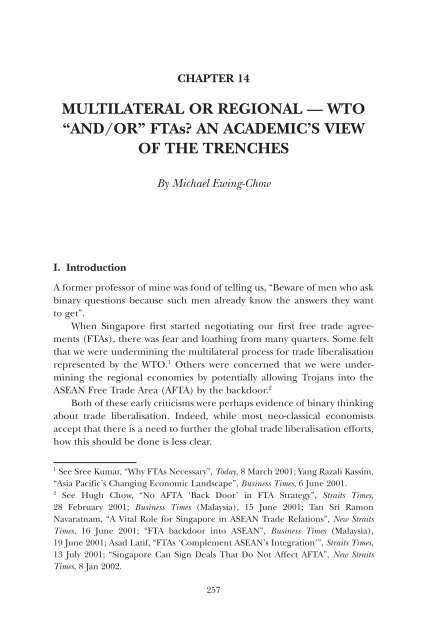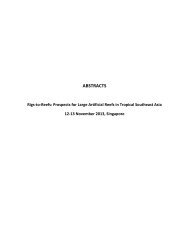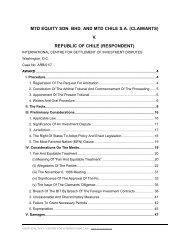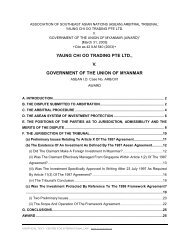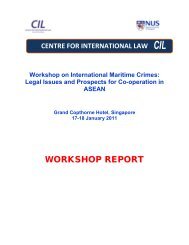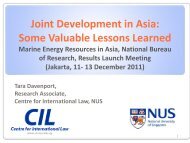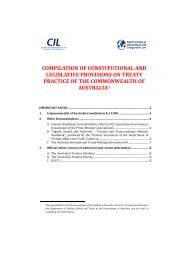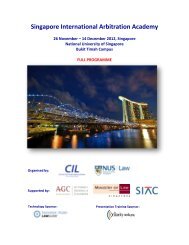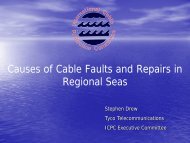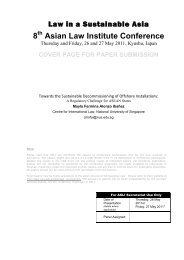View in PDF format - Centre for International Law
View in PDF format - Centre for International Law
View in PDF format - Centre for International Law
You also want an ePaper? Increase the reach of your titles
YUMPU automatically turns print PDFs into web optimized ePapers that Google loves.
1027_Chapter-14.qxd 10/28/2010 2:55 PM Page 257<br />
b1027 Economic Diplomacy<br />
CHAPTER 14<br />
MULTILATERAL OR REGIONAL — WTO<br />
“AND/OR” FTAs? AN ACADEMIC’S VIEW<br />
OF THE TRENCHES<br />
I. Introduction<br />
By Michael Ew<strong>in</strong>g-Chow<br />
A <strong>for</strong>mer professor of m<strong>in</strong>e was fond of tell<strong>in</strong>g us, “Beware of men who ask<br />
b<strong>in</strong>ary questions because such men already know the answers they want<br />
to get”.<br />
When S<strong>in</strong>gapore first started negotiat<strong>in</strong>g our first free trade agreements<br />
(FTAs), there was fear and loath<strong>in</strong>g from many quarters. Some felt<br />
that we were underm<strong>in</strong><strong>in</strong>g the multilateral process <strong>for</strong> trade liberalisation<br />
represented by the WTO. 1 Others were concerned that we were underm<strong>in</strong><strong>in</strong>g<br />
the regional economies by potentially allow<strong>in</strong>g Trojans <strong>in</strong>to the<br />
ASEAN Free Trade Area (AFTA) by the backdoor. 2<br />
Both of these early criticisms were perhaps evidence of b<strong>in</strong>ary th<strong>in</strong>k<strong>in</strong>g<br />
about trade liberalisation. Indeed, while most neo-classical economists<br />
accept that there is a need to further the global trade liberalisation ef<strong>for</strong>ts,<br />
how this should be done is less clear.<br />
1 See Sree Kumar, “Why FTAs Necessary”, Today, 8 March 2001; Yang Razali Kassim,<br />
“Asia Pacific’s Chang<strong>in</strong>g Economic Landscape”, Bus<strong>in</strong>ess Times, 6 June 2001.<br />
2 See Hugh Chow, “No AFTA ‘Back Door’ <strong>in</strong> FTA Strategy”, Straits Times,<br />
28 February 2001; Bus<strong>in</strong>ess Times (Malaysia), 15 June 2001; Tan Sri Ramon<br />
Navaratnam, “A Vital Role <strong>for</strong> S<strong>in</strong>gapore <strong>in</strong> ASEAN Trade Relations”, New Straits<br />
Times, 16 June 2001; “FTA backdoor <strong>in</strong>to ASEAN”, Bus<strong>in</strong>ess Times (Malaysia),<br />
19 June 2001; Asad Latif, “FTAs ‘Complement ASEAN’s Integration’”, Straits Times,<br />
13 July 2001; “S<strong>in</strong>gapore Can Sign Deals That Do Not Affect AFTA”, New Straits<br />
Times, 8 Jan 2002.<br />
257<br />
FA
1027_Chapter-14.qxd 10/28/2010 2:55 PM Page 258<br />
FA<br />
258 Michael Ew<strong>in</strong>g-Chow<br />
b1027 Economic Diplomacy<br />
In 2006, <strong>for</strong>mer Assistant <strong>for</strong> <strong>International</strong> Economic Affairs to Henry<br />
Kiss<strong>in</strong>ger, Fred Bergsten, wrote somewhat presciently <strong>in</strong> an op-ed <strong>for</strong> the<br />
F<strong>in</strong>ancial Times that:<br />
The <strong>in</strong>def<strong>in</strong>ite suspension of the Doha round of world trade talks creates<br />
big risks <strong>for</strong> the world economy. A new explosion of discrim<strong>in</strong>atory bilateral<br />
and regional agreements is likely to substitute <strong>for</strong> global<br />
liberalisation. This will <strong>in</strong>evitably erode the multilateral rules-based system<br />
of the World Trade Organisation (WTO). The backlash aga<strong>in</strong>st globalisation<br />
will generate more protectionism <strong>in</strong> the vacuum left as momentum<br />
toward wide-rang<strong>in</strong>g reduction of barriers ceases, especially as the world<br />
economy slows and global trade imbalances cont<strong>in</strong>ue to rise. F<strong>in</strong>ancial<br />
markets will become more unstable as <strong>in</strong>ternational economic cooperation<br />
breaks down further. 3<br />
Bergsten called upon APEC to launch a Free Trade Area of the Asia-Pacific<br />
(FTAAP) <strong>in</strong>itiative to provide:<br />
a “plan B” to get world trade policy back on track — to spur the revival of<br />
Doha, to offer an ambitious alternative to restart the process of liberalisation<br />
on the widest possible basis if that primary goal fails, and to<br />
counter the proliferation of preferential deals among small groups of<br />
countries. 4<br />
However, aga<strong>in</strong>, this statement perhaps evidences a b<strong>in</strong>ary approach to<br />
trade liberalisation with the underly<strong>in</strong>g assumption that it should be multilateral<br />
<strong>in</strong> preference to regional or bilateral.<br />
Unlike many trade law academics who cut their teeth <strong>in</strong> GATT or WTO<br />
negotiations, my first <strong>in</strong>troduction to trade negotiations occurred when I<br />
was appo<strong>in</strong>ted as a consultant <strong>for</strong> S<strong>in</strong>gapore’s early FTA negotiations right<br />
after we had concluded our first one — the Agreement between New<br />
Zealand and S<strong>in</strong>gapore on a Closer Economic Partnership (ANZSCEP). In<br />
particular, I became <strong>in</strong>volved <strong>in</strong> the Mexico-S<strong>in</strong>gapore FTA which un<strong>for</strong>tunately<br />
faced significant political hurdles when then Mexican President<br />
Vicente Fox and his Alliance <strong>for</strong> Change took over from the more trade liberal<br />
government of President Ernesto Zedillo <strong>in</strong> December 2000.<br />
3 Fred Bergsten, “Plan B <strong>for</strong> World Trade: Go Regional”, F<strong>in</strong>ancial Times (London),<br />
August 16, 2006.<br />
4 Ibid.
1027_Chapter-14.qxd 10/28/2010 2:55 PM Page 259<br />
b1027 Economic Diplomacy<br />
Now, S<strong>in</strong>gapore was not the only country to embark on FTA negotiations<br />
at that time. At the end of the 20th century, there was a surge <strong>in</strong><br />
bilateral FTAs follow<strong>in</strong>g the failure of the Third WTO M<strong>in</strong>isterial<br />
Conference held <strong>in</strong> Seattle <strong>in</strong> 1999 where an uneasy coalition of environmental<br />
and labour rights activists as well as protectionist lobby groups<br />
caused a collapse <strong>in</strong> trade negotiations. Dur<strong>in</strong>g this time, S<strong>in</strong>gapore also<br />
embarked on a series of bilateral FTAs. 5 The official position was that<br />
S<strong>in</strong>gapore saw FTAs as possible complements to the multilateral trade liberalisation<br />
process offered by the WTO. 6<br />
While I had no attachment to the WTO or the GATT, like many other<br />
trade academics, I had some reservations as to the wisdom of the FTA <strong>in</strong>itiative,<br />
believ<strong>in</strong>g that Seattle was only a blip on the road to trade<br />
liberalisation. I saw the value of hav<strong>in</strong>g alternatives but I was somewhat concerned<br />
that we were act<strong>in</strong>g prematurely and thus divert<strong>in</strong>g our attention<br />
from the ma<strong>in</strong> game of WTO negotiations. This changed after Cancun.<br />
II. A Change of <strong>View</strong>s<br />
Multilateral or Regional — WTO “and/or” FTAs? 259<br />
The WTO Fifth M<strong>in</strong>isterial Conference <strong>in</strong> Cancun, held <strong>in</strong> September<br />
2003, was tasked <strong>in</strong> the 2001 Doha M<strong>in</strong>isterial Declaration “to take stock of<br />
progress <strong>in</strong> the negotiations, to provide any necessary political guidance,<br />
and take decisions as necessary”. Sadly, the collapse of the talks on 14th<br />
September meant that these three ends could not be satisfactorily<br />
achieved.<br />
Although it would appear from the WTO’s summary of the Conference<br />
proceed<strong>in</strong>gs that the lack of agreement on modalities <strong>for</strong> the “S<strong>in</strong>gapore<br />
issues” 7 precipitated the collapse of the talks, 8 the chief reason beh<strong>in</strong>d the<br />
collapse <strong>in</strong> Cancun was ultimately due to the lack of progress on reduc<strong>in</strong>g<br />
5 Michael Ew<strong>in</strong>g-Chow, “Southeast Asia and Free Trade Agreements: WTO Plus or<br />
Bust?”, (2004) 8 SYBIL 193, 200.<br />
6 Margaret Liang, “S<strong>in</strong>gapore’s Trade Policies: Priorities and Options”, (2005) 22<br />
ASEAN Economic Bullet<strong>in</strong> 1, 13–14.<br />
7 The four issues are transparency <strong>in</strong> government procurement, <strong>in</strong>vestment, trade<br />
facilitation and competition. They are referred to as the S<strong>in</strong>gapore issues only<br />
because they were raised at the First WTO M<strong>in</strong>isterial Conference <strong>in</strong> S<strong>in</strong>gapore<br />
back <strong>in</strong> 1996.<br />
8 The WTO’s summary of the Conference proceed<strong>in</strong>gs is available onl<strong>in</strong>e at .<br />
FA
1027_Chapter-14.qxd 10/28/2010 2:55 PM Page 260<br />
FA<br />
260 Michael Ew<strong>in</strong>g-Chow<br />
b1027 Economic Diplomacy<br />
agricultural subsidies, and the cold treatment given to the cotton proposal<br />
raised by Ben<strong>in</strong>, Burk<strong>in</strong>a Faso, Chad and Mali. 9<br />
The issue of agricultural subsidies was of primary importance on the<br />
Cancun agenda as develop<strong>in</strong>g producer countries represented by the<br />
Group of 21 were <strong>in</strong>creas<strong>in</strong>gly <strong>in</strong>censed by generous subsidies <strong>in</strong> the <strong>for</strong>m<br />
of tax reliefs or import taxes given by developed states, particularly Japan,<br />
France and the United States, which distorted demand both <strong>in</strong> the import<strong>in</strong>g<br />
country concerned as well as <strong>in</strong> the produc<strong>in</strong>g country. With farmers<br />
be<strong>in</strong>g powerful lobby groups <strong>in</strong> these countries, political will<strong>in</strong>gness to<br />
remove such subsidies and to impose agricultural re<strong>for</strong>m is weak, especially<br />
<strong>in</strong> light of domestic elections, thus perpetuat<strong>in</strong>g the problem.<br />
The Group of 21 was <strong>for</strong>med prior to the Cancun M<strong>in</strong>isterial <strong>in</strong> an<br />
<strong>in</strong>censed response to the proposal submitted by the EU and the United<br />
States <strong>for</strong> the Cancun M<strong>in</strong>isterial, as it made no mention of reduc<strong>in</strong>g<br />
export subsidies, although it required agricultural re<strong>for</strong>ms to be made. 10<br />
Such a scheme was unsatisfactory to many develop<strong>in</strong>g countries, and the<br />
Group of 21, led by Brazil, Ch<strong>in</strong>a and India, was <strong>for</strong>med to push the richer<br />
developed nations to make more ambitious strides <strong>in</strong> reduc<strong>in</strong>g subsidies<br />
and free<strong>in</strong>g farm trade.<br />
Nevertheless, despite the difficulties aris<strong>in</strong>g from the standoff between<br />
the US and the EU on one hand and the Group of 21 on the other, it must<br />
be noted that accommodat<strong>in</strong>g political stances had been arrived at on Day 3<br />
of the Conference be<strong>for</strong>e the Agriculture Facilitator (then S<strong>in</strong>gapore’s<br />
M<strong>in</strong>ister <strong>for</strong> Trade and Industry, BG George Yeo), 11 but surpris<strong>in</strong>gly, there<br />
was no air<strong>in</strong>g and concretisation of the progress made over the past few<br />
days on Day 4, suggest<strong>in</strong>g that such stances had been reversed after the government<br />
officials <strong>in</strong>volved <strong>in</strong> the agricultural meet<strong>in</strong>gs reverted to their<br />
home countries <strong>for</strong> approval. This permitted underly<strong>in</strong>g tensions between<br />
the develop<strong>in</strong>g and developed countries to rise to the <strong>for</strong>e, and ultimately<br />
led to the collapse of the Conference via the “vehicle” of the “S<strong>in</strong>gapore<br />
issues”, when dispute raged over whether some or all of the issues should<br />
be discussed or postponed to a later time.<br />
9 See “The WTO Under Fire”, The Economist, 18 September 2003, available onl<strong>in</strong>e:<br />
.<br />
10 Supra n. 9.<br />
11 “BG George Yeo’s Mexican Beach Adventure: Cold Food, Little Sleep...and Some<br />
Tricky <strong>International</strong> Diplomacy”, The Sunday Times, 21 September 2003.
1027_Chapter-14.qxd 10/28/2010 2:55 PM Page 261<br />
b1027 Economic Diplomacy<br />
While several m<strong>in</strong>isters from states belong<strong>in</strong>g to the Group of 21<br />
expressed “joy” over the collapse, 12 many others rightly expressed sorrow<br />
over the lost opportunities <strong>for</strong> further beneficial economic ga<strong>in</strong>s due to the<br />
lack of compromise. 13 In particular, the poorest nations stand to lose the<br />
most as they have little to offer <strong>in</strong> bilateral trade negotiations with richer<br />
nations, and thus risk be<strong>in</strong>g sidel<strong>in</strong>ed <strong>in</strong> the global pursuit <strong>for</strong> economic<br />
growth. As such, while the reluctance of rich develop<strong>in</strong>g countries to<br />
remove or substantially reduce agricultural export subsidies is blameworthy,<br />
the unwill<strong>in</strong>gness of certa<strong>in</strong> develop<strong>in</strong>g countries to compromise and<br />
<strong>in</strong>sistence on hav<strong>in</strong>g “no deal” 14 other than one which comes substantially<br />
close to their preferred positions was curious.<br />
There<strong>for</strong>e, after Cancun, I began to reth<strong>in</strong>k the accepted academic<br />
position on FTAs. It began to dawn on me that perhaps the road to greater<br />
multilateral trade liberalisation would not be as smooth as many had <strong>in</strong>itially<br />
anticipated or as rational. As I thought about it more, it occurred to<br />
me that S<strong>in</strong>gapore, a country very dependent on trade, would be <strong>in</strong> an<br />
untenable position were it to stick with the “academically sound” option of<br />
only multilateral trade liberalisation.<br />
III. WTO or FTAs<br />
Multilateral or Regional — WTO “and/or” FTAs? 261<br />
Now, ideally, a global trad<strong>in</strong>g system would maximise the benefits from<br />
exploit<strong>in</strong>g the competitive and comparative advantages of all countries and<br />
reduce transactional costs. These benefits and sav<strong>in</strong>gs should then be<br />
passed on to the consumer. FTAs should not exist <strong>in</strong> such a multilateral<br />
trad<strong>in</strong>g system, as they potentially create preferential bilateral or regional<br />
markets that disrupt a level play<strong>in</strong>g field. This could cause trade that would<br />
normally flow to other countries to divert and flow between countries benefit<strong>in</strong>g<br />
from the preferential treatment, thus distort<strong>in</strong>g trade. 15 An example<br />
of this which is often cited is that when the US reduced or elim<strong>in</strong>ated tariffs<br />
on exports from Peru, Ecuador and Bolivia <strong>in</strong> the 1991 Andean Free<br />
12 Jeffrey Schott, “Unlock<strong>in</strong>g the Benefits of World Trade”, The Economist (US<br />
Edition), 1 November 2003.<br />
13 Supra n. 9.<br />
14 “Commentary: Cancun Sees World Split”, The Straits Times, 16 September 2003.<br />
15 Jaime Serra Puche, “Regionalism and the WTO”, <strong>in</strong> The WTO Secretariat, From<br />
GATT to the WTO: the Multilateral Trad<strong>in</strong>g System <strong>in</strong> the New Millennium (The Hague:<br />
Kluwer <strong>Law</strong> <strong>International</strong>, 2000), 123.<br />
FA
1027_Chapter-14.qxd 10/28/2010 2:55 PM Page 262<br />
FA<br />
262 Michael Ew<strong>in</strong>g-Chow<br />
b1027 Economic Diplomacy<br />
Trade Pact, demand <strong>for</strong> canned tuna from the Philipp<strong>in</strong>es, Indonesia and<br />
Thailand fell <strong>in</strong> favour of tuna from Ecuador. 16<br />
Un<strong>for</strong>tunately, we do not live <strong>in</strong> a world where states altruistically place<br />
the global welfare and common <strong>in</strong>terest over their own immediate self<strong>in</strong>terest.<br />
17 Ideally, states should balance their short-term self-<strong>in</strong>terest aga<strong>in</strong>st<br />
long-term self-<strong>in</strong>terest as part of a community of nations which would<br />
achieve significant aggregate ga<strong>in</strong>s from trade liberalisation. However, the<br />
global trad<strong>in</strong>g system operates <strong>in</strong> a political reality that is <strong>in</strong>creas<strong>in</strong>gly cautious<br />
about trade liberalisation, and many countries cont<strong>in</strong>ue to impose<br />
significant barriers to trade <strong>in</strong> goods and services.<br />
This is even so despite explicit agreement on important pr<strong>in</strong>ciples of<br />
trade law such as the pr<strong>in</strong>ciple of non-discrim<strong>in</strong>ation, as manifested <strong>in</strong><br />
GATT Articles I and III. Article I on MFN Treatment provides that the benefits<br />
accorded by any GATT member state to the products produced <strong>in</strong><br />
another state are automatically granted to other member states as well,<br />
while Article III on National Treatment obliges members not to treat “like”<br />
imports from another contract<strong>in</strong>g party <strong>in</strong> a manner which af<strong>for</strong>ds protection<br />
to domestic production.<br />
Sadly, contrary to the spirit of promot<strong>in</strong>g free trade as manifested <strong>in</strong> such<br />
pr<strong>in</strong>ciples, many developed countries cont<strong>in</strong>ue to impose trade barriers on<br />
agricultural produce, textiles and cloth<strong>in</strong>g, <strong>in</strong> which develop<strong>in</strong>g countries<br />
have a comparative advantage <strong>in</strong> produc<strong>in</strong>g. In addition, WTO member<br />
states are <strong>in</strong>creas<strong>in</strong>gly turn<strong>in</strong>g to non-tariff barriers (NTBs) to curb the<br />
degree to which imports compete with their domestic products. Often, <strong>in</strong>terest<br />
groups and protectionist power players can <strong>in</strong>fluence the trade policies of<br />
a country and governments may be persuaded to make trade policy decisions<br />
that are motivated by political rather than economic considerations.<br />
Yet, despite these limitations of the multilateral system, many people<br />
have been critical of the alternative that FTAs provide. The criticism of<br />
16 William Choong, “You and FTA: For Freer or For Poorer”, The Straits Times,<br />
25 Aug 2002, 39.<br />
17 A notably laudable exception to this statement occurred on 30 August 2003 when<br />
an <strong>in</strong>terim waiver (until TRIPS is amended) was made to the compulsory licens<strong>in</strong>g<br />
rule <strong>in</strong> Article 3(f) of TRIPS <strong>for</strong> eligible poorer countries who are unable to manufacture<br />
much needed medic<strong>in</strong>es, thus permitt<strong>in</strong>g them to import such cheaper<br />
generics. See “Decision removes f<strong>in</strong>al patent obstacle to cheap drug imports”, WTO<br />
Press Release, Press/350, 30 August 2003, available onl<strong>in</strong>e: .
1027_Chapter-14.qxd 10/28/2010 2:55 PM Page 263<br />
b1027 Economic Diplomacy<br />
Multilateral or Regional — WTO “and/or” FTAs? 263<br />
FTAs can be summed up <strong>in</strong>to three ma<strong>in</strong> categories: first, FTAs will cause<br />
trade diversion and distortion; second, FTAs will overwork limited trade<br />
negotiat<strong>in</strong>g resources; and, f<strong>in</strong>ally, FTAs will create a chaotic network of<br />
trade rules which are not harmonised and there<strong>for</strong>e will add to transaction<br />
costs.<br />
In light of present realities, FTAs are perhaps a “second best” 18 alternative<br />
to direct multilateral trade negotiations <strong>in</strong> foster<strong>in</strong>g trade<br />
liberalisation. As a tool of state policy-mak<strong>in</strong>g, they have numerous advantages.<br />
Apart from diplomatic and national security benefits and positive<br />
public relations with potential <strong>in</strong>vestors, they permit countries that wish to<br />
liberalise their economies at a faster and deeper pace to do so, 19 <strong>in</strong>stead of<br />
be<strong>in</strong>g held back by less will<strong>in</strong>g states <strong>in</strong> a phenomenon called the “convoy<br />
problem”. 20 They encourage <strong>for</strong>eign direct <strong>in</strong>vestments and also expose<br />
local <strong>in</strong>dustries to a limited degree of <strong>for</strong>eign competition, allow<strong>in</strong>g them<br />
some time to adjust prior to greater competition at the regional and<br />
multilateral levels.<br />
Further, FTA negotiations are more likely to succeed than multilateral<br />
trade negotiations as fewer parties are <strong>in</strong>volved, result<strong>in</strong>g <strong>in</strong> an <strong>in</strong>crease <strong>in</strong><br />
the efficiency and flexibility of trade discussions, especially amongst likem<strong>in</strong>ded<br />
countries. 21 The modalities of negotiat<strong>in</strong>g a bilateral or even<br />
regional FTA, when compared to the <strong>in</strong>evitably more difficult multilateral<br />
negotiat<strong>in</strong>g process of a large and diverse WTO membership, enable<br />
deeper understand<strong>in</strong>g of the concerns of other parties and the more ready<br />
development of trust amongst the negotiat<strong>in</strong>g parties. These advantages<br />
potentially enable FTA parties to commit themselves to trade liberalisation<br />
standards higher than those of the WTO. The problem is that due to the<br />
absence of strong <strong>in</strong>centives through “horse-trad<strong>in</strong>g” of key <strong>in</strong>terests<br />
between the big players, real significant ga<strong>in</strong>s are difficult to obta<strong>in</strong> via the<br />
18 The World Trade Report 2003, available onl<strong>in</strong>e: WTO website at 49.<br />
19 S. Laird, “Regional Trade Agreements: Dangerous Liaisons?” (1999) 22 The World<br />
Economy 1179, 1183.<br />
20 Ramkishen S. Rajan, Rahul Sen and Reza Siregar, “S<strong>in</strong>gapore and the New<br />
Regionalism: Bilateral Trade L<strong>in</strong>kages with Japan and the US”, August 2002<br />
(Second revision), available onl<strong>in</strong>e: at 3.<br />
21 Robert <strong>Law</strong>rence and Charles Schultze, An American Trade Strategy: Options <strong>for</strong> the<br />
1990s (Wash<strong>in</strong>gton DC: Institute <strong>for</strong> <strong>International</strong> Economics, 1989).<br />
FA
1027_Chapter-14.qxd 10/28/2010 2:55 PM Page 264<br />
FA<br />
264 Michael Ew<strong>in</strong>g-Chow<br />
b1027 Economic Diplomacy<br />
modality of bilateral FTAs between a typically bigger economy and a<br />
smaller one. Nonetheless, some ga<strong>in</strong>s are better than none and <strong>in</strong> the case<br />
of some of S<strong>in</strong>gapore’s FTAs, they have <strong>for</strong>ced us to become com<strong>for</strong>table<br />
with certa<strong>in</strong> rules such as “negative list<strong>in</strong>g” <strong>for</strong> services and very liberal<br />
<strong>in</strong>vestor-to-state arbitration rules. This required some significant amount of<br />
coord<strong>in</strong>ation with all the affected stakeholders and a lot of housekeep<strong>in</strong>g<br />
but I believe that once done, we then were <strong>in</strong> a stronger position as far as<br />
be<strong>in</strong>g prepared <strong>for</strong> trade liberation was concerned.<br />
The concern that FTAs would dra<strong>in</strong> limited negotiat<strong>in</strong>g resources has<br />
also not been proven to be the case. Many countries have actually developed<br />
trade negotiat<strong>in</strong>g resources through the FTA negotiat<strong>in</strong>g process. The trade<br />
negotiat<strong>in</strong>g team <strong>for</strong> S<strong>in</strong>gapore, <strong>for</strong> example, has more than doubled<br />
S<strong>in</strong>gapore’s capacity s<strong>in</strong>ce S<strong>in</strong>gapore began its FTA ef<strong>for</strong>ts. Of course,<br />
S<strong>in</strong>gapore is <strong>in</strong> the happy position of be<strong>in</strong>g able to pay <strong>for</strong> capacity build<strong>in</strong>g,<br />
and <strong>in</strong> the S<strong>in</strong>gapore-Mexico FTA situation, be<strong>in</strong>g our first FTA<br />
negotiation with a NAFTA member, we were able to pay <strong>for</strong> <strong>for</strong>eign counsel<br />
like Christopher Thomas and Greg Tereposky to tra<strong>in</strong> the team on NAFTA<br />
and <strong>in</strong> particular the work<strong>in</strong>gs of Chapter 11, the <strong>in</strong>vestment protection<br />
chapter. Even then, retention has been a problem and many have moved<br />
<strong>in</strong>ternally with<strong>in</strong> the civil service or have left the service. The upside of this,<br />
however, is that the experience of trade negotiations have added to the<br />
expertise of many who have been <strong>in</strong>volved and this has created capacity <strong>in</strong><br />
the relevant m<strong>in</strong>istries, the Attorney-General’s Chambers (AGC) and even<br />
<strong>in</strong> academia and there<strong>for</strong>e <strong>in</strong>directly expanded S<strong>in</strong>gapore’s capacity <strong>in</strong> this<br />
regard. 22 The trade negotiation network suggested by Ong Ye Kung back <strong>in</strong><br />
2001 to alleviate this migration of personnel was <strong>for</strong>esighted, though <strong>in</strong><br />
recent years, due perhaps to a pipel<strong>in</strong>e of sufficient expertise hav<strong>in</strong>g been<br />
developed <strong>in</strong>-house by MTI and AGC, this has not been much used.<br />
F<strong>in</strong>ally, the prediction that chaos rather than harmony would be the<br />
result of bilateral or regional development of trade rules rather than a multilateral<br />
process has also not come to pass. Instead, a comparison of most<br />
of the recent FTAs shows a similarity of structure and even at times a similarity<br />
<strong>in</strong> the text. The obvious reason <strong>for</strong> this is that the trade negotiators,<br />
and even more so the lawyers <strong>in</strong>volved <strong>in</strong> the “legal scrubb<strong>in</strong>g” of the text,<br />
often look to exist<strong>in</strong>g models <strong>for</strong> guidance rather than ventur<strong>in</strong>g <strong>in</strong>to the<br />
22 Indeed, just <strong>in</strong> academia, the number of trade law-related courses have <strong>in</strong>creased<br />
significantly s<strong>in</strong>ce we started our FTA <strong>in</strong>itiatives thus <strong>in</strong>directly also provid<strong>in</strong>g a<br />
pipel<strong>in</strong>e <strong>for</strong> new negotiators.
1027_Chapter-14.qxd 10/28/2010 2:55 PM Page 265<br />
b1027 Economic Diplomacy<br />
unknown. Further, not all trade issues need to be harmonised. Only those<br />
discipl<strong>in</strong>es which would be a barrier to trade or would add more directly to<br />
trade costs would need to be harmonised. Other “protective” rules like<br />
competition, <strong>in</strong>vestment and the environment may well be better developed<br />
through the easier modalities of negotiat<strong>in</strong>g and implement<strong>in</strong>g a<br />
bilateral or regional FTA than the multilateral process. The ma<strong>in</strong> transactional<br />
cost has been the need <strong>for</strong> Rules of Orig<strong>in</strong> (ROOs) to determ<strong>in</strong>e<br />
qualify<strong>in</strong>g goods <strong>for</strong> prefential FTA treatment. Often the cost of certify<strong>in</strong>g<br />
that the ROOs are met are sufficiently high that traders prefer to use the<br />
GATT rates where such rates result <strong>in</strong> lower or almost equivalent costs to<br />
the cost of ROO certification.<br />
Nonetheless, even if FTAs generally have been less bad than <strong>in</strong>itially<br />
anticipated, it should be noted that smaller and poorer develop<strong>in</strong>g<br />
economies have less barga<strong>in</strong><strong>in</strong>g power and are at a disadvantage when<br />
negotiat<strong>in</strong>g FTAs with more developed states, s<strong>in</strong>ce they would not be able<br />
to br<strong>in</strong>g enough to the barga<strong>in</strong><strong>in</strong>g table. This can be ameliorated to some<br />
degree by band<strong>in</strong>g with other similar states and negotiat<strong>in</strong>g as a bloc. 23<br />
Regardless, even if such smaller states are <strong>for</strong>ced to give many concessions<br />
<strong>in</strong> FTA negotiations, it may be better to give such concessions earlier and<br />
to endure some pa<strong>in</strong>, than to be placed at a long-term competitive disadvantage<br />
vis-à-vis competitors who are participants <strong>in</strong> an FTA and are thus at<br />
the receiv<strong>in</strong>g end of FTA benefits. 24<br />
IV. WTO and FTAs<br />
Multilateral or Regional — WTO “and/or” FTAs? 265<br />
How should we then evaluate this FTA phenomenon aga<strong>in</strong>st the established<br />
<strong>in</strong>stitution of the WTO? In this regard, the epistemic standard of<br />
“legitimacy”, as suggested by Buchanan and Keohane, 25 of “m<strong>in</strong>imal moral<br />
acceptability, comparative benefit and <strong>in</strong>stitutional <strong>in</strong>tegrity” 26 may be<br />
an effective (even if largely utilitarian) method to evaluate <strong>in</strong>stitutions<br />
(or regimes) <strong>for</strong> trade liberalisation. While Buchanan and Keohane po<strong>in</strong>t<br />
23 WTO Annual Report of the Director General, 2001.<br />
24 This is the “dom<strong>in</strong>o regionalism” theory which has been used to expla<strong>in</strong> the<br />
recent sharp <strong>in</strong>crease <strong>in</strong> FTA membership. See the World Trade Report 2003 at 50,<br />
supra n. 18.<br />
25 Allen Buchanan and Robert O. Keohane, “The Legitimacy of Global Governance<br />
Institutions”, (2006) 20 Ethics and <strong>International</strong> Affairs 405.<br />
26 Ibid, 424.<br />
FA
1027_Chapter-14.qxd 10/28/2010 2:55 PM Page 266<br />
FA<br />
266 Michael Ew<strong>in</strong>g-Chow<br />
b1027 Economic Diplomacy<br />
out that their “three substantive conditions are best thought of as what<br />
Rawls calls ‘count<strong>in</strong>g pr<strong>in</strong>ciples’: the more of them an <strong>in</strong>stitution or regime<br />
satisfies, and the higher the degree to which it satisfies them, the stronger<br />
its claim to legitimacy”. 27<br />
There<strong>for</strong>e, the “legitimacy” of the WTO as a trade facilitat<strong>in</strong>g <strong>in</strong>stitution<br />
may well be exam<strong>in</strong>ed by apply<strong>in</strong>g these standards to the WTO and<br />
contrast<strong>in</strong>g it with the FTA regime.<br />
If we assume m<strong>in</strong>imal moral acceptability <strong>in</strong> the belief that generally<br />
trade liberalisation is an economically good th<strong>in</strong>g, we are left with the two<br />
conditions of comparative benefit (it must be more effective at trade liberalisation<br />
than other equivalent <strong>in</strong>stitutions or regimes) and <strong>in</strong>stitutional<br />
<strong>in</strong>tegrity (the <strong>in</strong>ternal rules of the <strong>in</strong>stitution or regime must be consistent<br />
with its stated purpose).<br />
The big problem with the WTO <strong>in</strong> recent years is that its mandate is no<br />
longer clear. As Debra Steger puts it:<br />
This is a major problem <strong>in</strong> the Doha Round that is contribut<strong>in</strong>g to its<br />
current impasse. The old analogy used by trade policy “<strong>in</strong>siders” was that<br />
trade liberalisation with<strong>in</strong> the GATT was like a bicycle — you had to<br />
keep pedall<strong>in</strong>g, or you would fall off. Sylvia Ostry observed some years<br />
ago that it would be more appropriate to describe the post-Uruguay<br />
Round WTO as a bus with many drivers, and no one knows where it is<br />
go<strong>in</strong>g. 28<br />
While especially developed country negotiators would describe the<br />
purpose of the WTO as solely dedicated to trade liberalisation, it is clear<br />
that the develop<strong>in</strong>g country members of the WTO (which now <strong>for</strong>m the<br />
vast majority of its membership) also view development as a key goal of<br />
the organisation. There is presently, it is fair to say, no common understand<strong>in</strong>g<br />
on what the mandate of the WTO is. However, if one takes <strong>in</strong>to<br />
account the views of two-thirds of its membership, it is clear that the WTO<br />
serves the development agenda, and is no longer solely concerned with<br />
the goal of accelerat<strong>in</strong>g trade liberalisation. 29<br />
27 Ibid.<br />
28 Sylvia Ostry, “The Uruguay Round North-South Grand Barga<strong>in</strong>: Implications <strong>for</strong><br />
future negotiations”, <strong>in</strong> Daniel L. M. Kennedy and James D. Southwick (eds.), The<br />
Political Economy of <strong>International</strong> Trade <strong>Law</strong>, Essays <strong>in</strong> Honor of Robert E. Hudec<br />
(Cambridge: Cambridge University Press, 2002), 285–300.<br />
29 Debra P. Steger, “The Culture of the WTO: Why It Needs to Change”, 10 JIEL<br />
(2007), 483–495.
1027_Chapter-14.qxd 10/28/2010 2:55 PM Page 267<br />
b1027 Economic Diplomacy<br />
Multilateral or Regional — WTO “and/or” FTAs? 267<br />
I like Ostry’s metaphor of a bus. Indeed, the problems arise from the<br />
metaphorical vehicle of the WTO itself. As highlighted above, the steer<strong>in</strong>g<br />
mechanism, and perhaps even the eng<strong>in</strong>e and the provisions <strong>in</strong> case of a<br />
blow-up — correspond<strong>in</strong>g to the decision-mak<strong>in</strong>g process, the Secretariat<br />
and the dispute settlement mechanisms respectively — will probably<br />
require future development and f<strong>in</strong>e-tun<strong>in</strong>g. Indeed many proposals have<br />
been submitted on these fronts. However, if WTO negotiations do not<br />
occur under the shadow of a real competitor regime able to provide comparative<br />
benefit, it is too easy <strong>for</strong> those re<strong>for</strong>ms to stall due to the consensus<br />
method of decision-mak<strong>in</strong>g <strong>in</strong> the WTO.<br />
Thus, rather than see<strong>in</strong>g FTAs as an “either/or” alternative to the WTO,<br />
perhaps like Bergsten, we can see FTAs as <strong>in</strong>centivis<strong>in</strong>g progress on the multilateral<br />
front. However, unlike Bergsten, we could perhaps see the end<br />
result not as gett<strong>in</strong>g the multilateral process to move <strong>for</strong>ward but rather<br />
trade to be liberalised by any method, even one which may be second best.<br />
This is particularly true if the second best option is actually the only current<br />
option and there<strong>for</strong>e the alternative is not “either/or” but rather “and/or”.<br />
Go<strong>in</strong>g back to the Buchanan and Keohane model, if one cont<strong>in</strong>ues to<br />
believe that the WTO raison d’être is trade liberalisation, one could perhaps<br />
po<strong>in</strong>t out that the “comparative benefit” of the FTA regime at the moment<br />
outweighs that of the WTO while the trade negotiations are stalled. Should<br />
the WTO overcome its current impasse, the equation might change aga<strong>in</strong><br />
and if so, the legitimacy of the FTA regime as a trade liberalisation option<br />
might correspond<strong>in</strong>gly be reduced <strong>in</strong> favour of the multilateral process.<br />
As far as <strong>in</strong>stitutional <strong>in</strong>tegrity goes, much depends on whether the FTA<br />
is one that encourages open regionalisation <strong>in</strong>stead of a closed club only <strong>for</strong><br />
selected members. FTAs founded upon the concept of “open regionalism”<br />
were espoused <strong>in</strong> the 1995 APEC summit as the key to reviv<strong>in</strong>g the languish<strong>in</strong>g<br />
multilateral Doha Round discussions 30 by encourag<strong>in</strong>g closer <strong>in</strong>tegration<br />
30 In particular, negotiations on agriculture have stagnated, and this has affected<br />
negotiations <strong>in</strong> other areas, such as <strong>in</strong> services. As of 1 June 2003, WTO members<br />
have failed to adhere to deadl<strong>in</strong>es to conclude modalities <strong>for</strong> the negotiations on<br />
<strong>in</strong>dustrial tariffs and non-tariff barriers, and to amend and clarify the Dispute<br />
Settlement Understand<strong>in</strong>g. As a result, decision-mak<strong>in</strong>g on these two issues, if any,<br />
is likely to be deferred to the Cancun M<strong>in</strong>isterial <strong>in</strong> September. See “WTO<br />
Members Miss Additional Key Deadl<strong>in</strong>es: Preparations <strong>for</strong> Cancun M<strong>in</strong>isterial Set<br />
to Intensify”, WTO Doha Development Agenda Negotiations <strong>in</strong> 2003 Report No. 3,<br />
(Geneva: WCI Consult<strong>in</strong>g Private Limited, June 2003).<br />
FA
1027_Chapter-14.qxd 10/28/2010 2:55 PM Page 268<br />
FA<br />
268 Michael Ew<strong>in</strong>g-Chow<br />
b1027 Economic Diplomacy<br />
between the economies of states. Open regionalism requires FTAs to be<br />
drafted <strong>in</strong> a transparent manner that encourages and permits other states to<br />
jo<strong>in</strong> <strong>in</strong> later. In addition, such an FTA must also be committed to outwardlook<strong>in</strong>g<br />
trade and development policies, trade and <strong>in</strong>vestment liberalisation<br />
and consistency with GATT and WTO law and policy. 31 FTAs structured <strong>in</strong><br />
such an “open” manner would permit the benefits from <strong>in</strong>creased productivity<br />
to trickle down to those not part of the FTA, and would m<strong>in</strong>imise the<br />
“them versus us” psychology 32 <strong>in</strong>herent <strong>in</strong> a discrim<strong>in</strong>atory trade bloc.<br />
Sadly, as po<strong>in</strong>ted out by Sung-Hoon Park, the lack of clear modalities<br />
as to how open regionalism is to be achieved has hampered greater trade<br />
liberalisation via the concept amongst APEC member states. 33 However, the<br />
application of the concept to other bilateral and regional FTAs should not<br />
create similarly <strong>in</strong>surmountable problems if “good faith” 34 sensitivity is displayed<br />
to the difficulties faced by potential new FTA members who are<br />
poorer develop<strong>in</strong>g economies when apply<strong>in</strong>g a conditional MFN model 35<br />
to the concept.<br />
In this regard, clauses such as Article 79:2 of the ANZSCEP could help<br />
facilitate greater trade liberalisation. The article states that <strong>in</strong> facilitat<strong>in</strong>g<br />
the accession of new members,<br />
[t]he terms of such accession or association shall take <strong>in</strong>to account the circumstances<br />
of the Member of the WTO, State or separate customs<br />
territory, <strong>in</strong> particular with respect to timetables <strong>for</strong> liberalisation.<br />
It is argued, however, that a better clause would go further and s<strong>in</strong>gle out<br />
“reciprocal liberalisation commitments” when tak<strong>in</strong>g <strong>in</strong>to account the<br />
31 P. Drysdale, A. Elek and H. Soesastro, “Open Regionalism: the nature of Asia<br />
Pacific Integration”, <strong>in</strong> P. Drysdale et al. (eds.), Europe, East Asia and APEC, A Shared<br />
Global Agenda? (Cambridge: Cambridge University Press, 1998), 103.<br />
32 A.H. Qureshi, “The Role of GATT <strong>in</strong> the Management of Trade Blocs” (1993) 27<br />
Journal of World Trade 101, 105.<br />
33 Sung-Hoon Park, “Regionalism, Open Regionalism and Article XXIV GATT:<br />
Conflicts and Harmony”, <strong>in</strong> Francis Snyder (ed.), Regional and Global Regulation of<br />
<strong>International</strong> Trade (2002: Hart Publish<strong>in</strong>g, Oregon), 270.<br />
34 Michael J. Trebilcock and Robert Howse, The Regulation of <strong>International</strong> Trade<br />
(New York: Routledge, 2000), 521.<br />
35 To resolve the problem of free-rid<strong>in</strong>g states if an unconditional MFN model is<br />
adopted.
1027_Chapter-14.qxd 10/28/2010 2:55 PM Page 269<br />
b1027 Economic Diplomacy<br />
Multilateral or Regional — WTO “and/or” FTAs? 269<br />
circumstances of the potential new member concerned, s<strong>in</strong>ce the degree<br />
to which FTAs can hasten the liberalisation of the multilateral trad<strong>in</strong>g<br />
regime depends <strong>in</strong> part on some accommodation of the <strong>in</strong>terests of poorer<br />
develop<strong>in</strong>g new members by the more developed “older” member states.<br />
Indeed, on the sidel<strong>in</strong>es of the APEC M<strong>in</strong>isters Responsible <strong>for</strong> Trade<br />
(MRT) meet<strong>in</strong>g <strong>in</strong> Jeju, Korea, the m<strong>in</strong>isters of Brunei, Chile, New Zealand<br />
and S<strong>in</strong>gapore announced the conclusion of the Trans-Pacific Strategic<br />
Economic Partnership Agreement (“Trans-Pacific SEP”) on 3 June 2005.<br />
This Trans-Pacific SEP was <strong>in</strong>deed built on the commitments made under<br />
the ANZSCEP, and the <strong>in</strong>clusion of like-m<strong>in</strong>ded parties such as Brunei to<br />
the already ongo<strong>in</strong>g trade negotiation process demonstrated the potential<br />
of the Trans-Pacific SEP to grow <strong>in</strong>to a larger strategic agreement <strong>for</strong> trade<br />
liberalisation. While it must be admitted that all four members of the FTA<br />
are relatively small, trade liberal economies, the architecture of the<br />
Agreement made th<strong>in</strong>gs easier. Article 20.6, paragraph 1 of the Trans-<br />
Pacific SEP specifically provides that<br />
[t]his Agreement is open to accession on terms to be agreed among the<br />
Parties, by any APEC Economy or other State. The terms of such accession<br />
shall take <strong>in</strong>to account the circumstances of that APEC Economy or other<br />
State, <strong>in</strong> particular with respect to timetables <strong>for</strong> liberalisation.<br />
Thus, if both the WTO as an <strong>in</strong>stitution and some FTA regimes have <strong>in</strong>stitutional<br />
<strong>in</strong>tegrity <strong>in</strong> that the <strong>in</strong>ternal rules provide <strong>for</strong> open trade<br />
liberalisation, allow<strong>in</strong>g non-members to relatively easily slot <strong>in</strong>to an exist<strong>in</strong>g<br />
agreement by accession, then the issue is not really a disjunctive choice<br />
between the WTO and FTAs but rather how best to calibrate the conjunctive<br />
option. I believe that S<strong>in</strong>gapore has chartered the correct path <strong>for</strong><br />
itself, tak<strong>in</strong>g <strong>in</strong>to account both its short-term and long-term <strong>in</strong>terest by<br />
strategically embark<strong>in</strong>g on FTAs vital to its position as a trade hub while<br />
cont<strong>in</strong>u<strong>in</strong>g to be very <strong>in</strong>vested <strong>in</strong> the WTO multilateral process through<br />
direct <strong>in</strong>terventions <strong>in</strong> the trade negotiations, active participation <strong>in</strong> various<br />
attempts to restart the process and a cont<strong>in</strong>ued commitment to<br />
regional WTO law and policy capacity build<strong>in</strong>g through activities like the<br />
Regional Trade Policy Course that Margaret Liang oversees at the National<br />
University of S<strong>in</strong>gapore. Basically, it does not matter which vehicle takes us<br />
to the dest<strong>in</strong>ation of further trade liberalisation; so long as they are not<br />
mutually exclusive, a comb<strong>in</strong>ation of the vehicular options allows <strong>for</strong> legitimate<br />
strategies towards the f<strong>in</strong>al dest<strong>in</strong>ation.<br />
FA
1027_Chapter-14.qxd 10/28/2010 2:55 PM Page 270<br />
FA<br />
270 Michael Ew<strong>in</strong>g-Chow<br />
V. Conclusion<br />
b1027 Economic Diplomacy<br />
I started with Bergsten and I shall end with Bergsten who envisages that:<br />
[A]n FTAAP would embed these Asia-only arrangements <strong>in</strong> a broader<br />
Asia-Pacific framework. It would prevent the creation of a new division<br />
across the Pacific, with its adverse security as well as economic consequences<br />
<strong>for</strong> relations between East Asia and the United States. The United<br />
States and Ch<strong>in</strong>a would be the natural leaders of an FTAAP process and<br />
could simultaneously improve the prospects <strong>for</strong> resolv<strong>in</strong>g their bilateral<br />
trade tensions through such a regional framework.<br />
If this is <strong>in</strong>deed one possibility, then S<strong>in</strong>gapore’s “open regionalism” FTAs<br />
have prepared us to be part of that f<strong>in</strong>al FTAAP <strong>in</strong>frastructure. The trick<br />
will be how to <strong>in</strong>clude other less developed Asian states <strong>in</strong> a way that the<br />
multilateral process at the moment does best by reduc<strong>in</strong>g their negotiation<br />
costs and allow<strong>in</strong>g them to obta<strong>in</strong> the ga<strong>in</strong>s derived from the concessions<br />
“horse-traded” between the bigger economic powers. Nonetheless, pr<strong>in</strong>ciples<br />
may be gleaned from S<strong>in</strong>gapore’s FTA <strong>in</strong>itiatives. First, avoid putt<strong>in</strong>g<br />
all eggs <strong>in</strong>to one basket and, where options are not mutually exclusive,<br />
avoid clos<strong>in</strong>g off those options. Second, problems may be alleviated by<br />
strategic solutions properly implemented. F<strong>in</strong>ally, an open approach is generally<br />
more legitimate than one based on closed doors.


